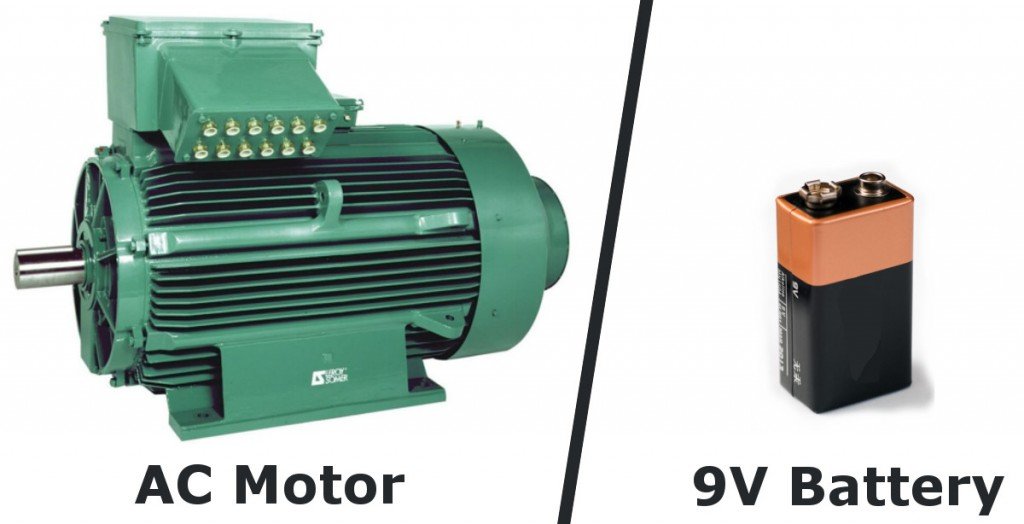Table of Contents (click to expand)
The current (electric charge) only flows in one direction in case of DC (direct current). But in AC (Alternating current) electric charge changes direction periodically. Not only current but also the voltage reverses because of the change in the current flow.
The AC versus DC debate personifies the War of Currents, as it is called today, in which the two giants of electrical energy were involved in the late 1890s. Thomas Edison, the owner of Direct Current, was so threatened by Tesla’s invention that he resorted to the false misleading of Americans to discredit Alternating Current.

But that did not stop Tesla from realizing its dream of supplying the United States with cheap and highly efficient energy. To this day, we see long, and thick wires stretched tightly between towering electric poles like the strings of a guitar. AC took the throne and ruled for a century, dominating homes, offices, and buildings until now, when DC seems to be gradually making a comeback. Why did AC fare so well? And why might DC make a comeback?
Let’s rephrase these questions.
Why Is AC Better Than DC?
AC is a type of current in which the electrons periodically change direction back and forth. It is based on the principles Michael Faraday invented in 1832 when he illustrated his dynamo generator.
DC, despite its fame, had a major problem – its transmission over long distances was tough, the wires lost power, and it had to be tapered by additional circuits. Moreover, upgrading or downgrading DC voltages also required complicated circuits.
Not only could alternating current be easily transmitted over long distances, but it could also be easily converted into higher or lower values using transformers.
A transformer is essentially a coiled-up wire that “steps up” or “steps down” the magnitude of AC voltage. The ability to transform voltage in this manner meant that it was possible to transmit electrical power much more efficiently, not only across cities but across the entire nation. Tesla’s dream was gradually becoming a reality.

The ability to transport electricity over long distances was AC’s main advantage over DC, with homes and buildings cutting off direct current in the 19th century. In 1893, General Electric was selected to supply DC power to Chicago World’s Fair, which would cost an exorbitant $554,000.
However, George Westinghouse intervened and promised to power the fair for only $399,000 with Tesla’s AC. Three years later, Niagara Falls Power Company, seduced by AC’s amenities, awarded Westinghouse the right to generate power from Niagara Falls and illuminate all of Buffalo, New York. AC obliterated DC once and for all. Then, a few decades later, the transistor was born.
Also Read: Why Different Countries Have Different Standard Voltages?
Why Is DC Better Than AC?
Unlike alternating current, direct current is not subject to switching. There are no periods, and the current flows in one direction at a constant voltage. As already mentioned, DC tends to lose electricity as heat – a property that Edison took advantage of to light the first light bulb.
Despite its disadvantages, the semiconductor age forced the return of direct current. DC is mainly used to power electronic devices, namely smaller devices that can only function in two states: on and off. These include batteries, LEDs, transistors, computer technology neurons, and any other semiconductor device.
DC power has made a comeback because our society relies on computers, tablets, and portable devices that are constantly connected to “clouds.” Clouds are basically computers, formally known as servers, stored in remote buildings to store your valuable data.
Today, companies like Facebook and Google empty entire buildings to house servers that store data for their ever-increasing number of users. Manipulating alternating current like direct current on such devices is quite complicated, as it requires elaborate circuits. However, most importantly, AC loses its energy, albeit for an infinitesimal time, which constantly power-hungry servers cannot endure.

Furthermore, every electrical engineer knows that losses accumulated by AC transmission can exceed the losses incurred by DC due to Skin Effect and capacitive coupling, phenomena where, because the energy flows on the wire’s surface, it is absorbed by objects beneath it.
The transmission slows down due to these resistances, consequently diminishing its efficiency. In fact, the losses dispersed in its vicinity form how wireless power transfer mechanisms are structured. AC radiates some of its energy, which can be conveniently concentrated in a region by suitably coiling the wire.
Another reason why – and this seems to be the most important – DC could return is its compatibility with environmentally friendly electronic devices. Since all solar cells are based on semiconductor substrates, they all generate or work with direct current. DC may have to return for the sake of renewable energy.
Of course, we can also recruit alternating current, but this would require tedious conversions from DC to AC using an inverter and then to DC again, where 5-20% of energy is lost as heat. In fact, data centers spanning whole acres do use these converters. Still, they consume huge amounts of energy and the additional cost of cooling systems for the heat generated, which exacerbates their financial plight.
Also Read: What Is A Transformer?
So Which Is Better, AC Or DC?
Although we now have the technology to transmit direct current over long distances over networks, we still use alternating current. AC is pushed to higher voltages to overcome resistance, and when the power reaches the user, it is stepped down and rectified to power, for example, a computer. However, these technologies, like renewable technologies, not only cost a fortune, but their efficiency might also be questionable. Yes, DC provides stable outputs, but higher efficiency is achieved after eliminating losses.

Although the losses might be less than those incurred with AC, the step-up/down factor comes into play. The simplicity with which AC voltages can be modulated and transported is still out of reach, so AC voltage could still be preferred.
Both power sources are excellent in their own way, so the decision on who triumphs would depend on the contentious criteria – the playing field. Judgment essentially depends on the application of power.
Nowadays, both work in tandem. Alternating current flows above us in wires. The alternating current is then converted into direct current using a rectifier, such as the adapter that your charger contains, to power household appliances such as light bulbs, lamps, and other appliances.
The War of Currents might not be as dramatic as it once was, but it still subtly exists.
How much do you know about AC and DC?

References (click to expand)
- What's the difference between AC and DC?. The MIT School of Engineering
- The War of the Currents: AC vs. DC Power. The United States Department of Energy
- Tesla turns in his grave: Is it finally time to switch from AC to DC?. ExtremeTech
- Edison's Revenge: Will Direct Current Make a Comeback in .... Scientific American
